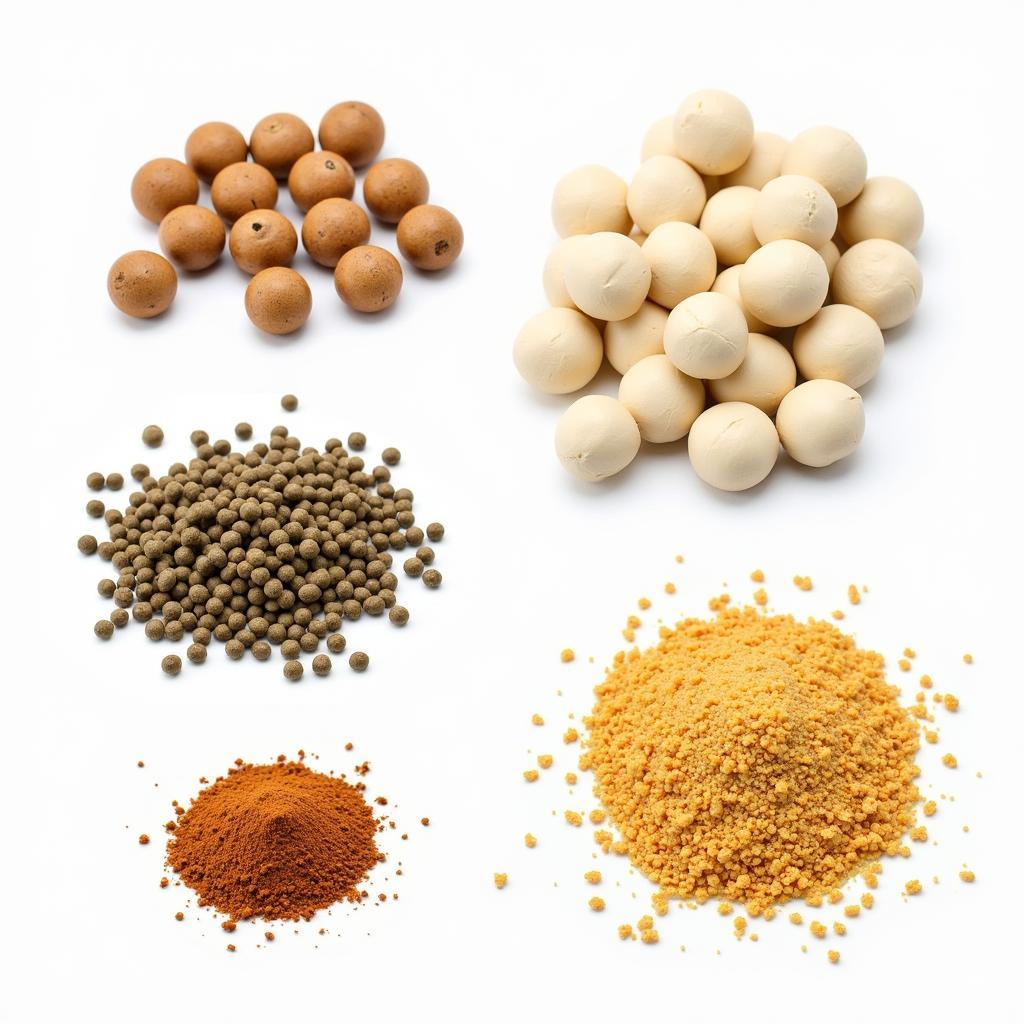Plant Food Pellets offer a convenient and effective way to nourish your plants. Whether you’re a seasoned gardener or just starting out, understanding how these concentrated nutrients work can significantly impact the health and vibrancy of your green companions. Let’s delve into the world of plant food pellets and uncover their benefits, different types, and best practices for application.
What are Plant Food Pellets and Why Use Them?
Plant food pellets are essentially concentrated nutrients compressed into small, easy-to-handle pellets. They provide a slow-release feeding method, gradually delivering essential nutrients to your plants over an extended period. This sustained release minimizes the risk of over-fertilizing, which can damage or even kill your plants. Using plant food pellets can also reduce the frequency of feeding, saving you time and effort.
 Close-up of various plant food pellets
Close-up of various plant food pellets
Different Types of Plant Food Pellets: Catering to Specific Needs
Not all plant food pellets are created equal. They come in various formulations tailored to the specific needs of different plant types. Some cater to the unique requirements of flowering plants, while others focus on supporting the vigorous growth of leafy greens. You can also find specialized pellets designed for acid-loving plants like azaleas and camellias. Understanding the nutritional profile of each type will help you choose the best option for your garden. For instance, if you are looking to boost the growth of your leafy greens, a pellet high in nitrogen would be ideal. Are you aiming for vibrant blooms? Then a pellet richer in phosphorus and potassium will be more effective.
Do you have young rabbits that need the proper nutrition? Check out our guide on rabbit food for young rabbits.
Choosing the Right Plant Food Pellets: Deciphering the NPK Ratio
The NPK ratio, representing the percentage of nitrogen (N), phosphorus (P), and potassium (K) in the fertilizer, is a key factor in selecting the appropriate plant food pellets. Nitrogen promotes leafy growth, phosphorus supports root development and flowering, while potassium contributes to overall plant health and disease resistance. A balanced NPK ratio, such as 10-10-10, is suitable for general-purpose use. However, for specific needs, you might opt for a higher nitrogen content for foliage growth or a higher phosphorus and potassium content for flowering.
 Applying plant food pellets to potted plants
Applying plant food pellets to potted plants
“Understanding the NPK ratio is crucial for successful gardening. It’s like providing a balanced diet for your plants, ensuring they receive the right nutrients for optimal growth and health,” says renowned horticulturalist, Dr. Emily Carter.
How to Use Plant Food Pellets Effectively: A Step-by-Step Guide
Applying plant food pellets is typically straightforward. First, gently incorporate the pellets into the top layer of soil around the plant’s base, being careful not to disturb the roots. Then, water the area thoroughly to activate the slow-release mechanism. The frequency of application depends on the type of plant and the specific pellet instructions. Always follow the manufacturer’s recommendations for best results. Over-fertilizing can lead to nutrient burn and other problems, so it’s essential to use the correct amount.
Have you ever wondered about the fish food pellets?
Benefits of Using Plant Food Pellets: A Sustainable Approach
Plant food pellets offer several advantages beyond their ease of use. Their slow-release nature minimizes nutrient runoff, reducing environmental impact. This makes them a more sustainable choice compared to liquid fertilizers, which can be easily washed away by rain or overwatering. Furthermore, the controlled release of nutrients prevents rapid growth spurts, leading to stronger, healthier plants.
 Vibrant, healthy plants after plant food pellet application
Vibrant, healthy plants after plant food pellet application
“Plant food pellets are a game-changer for busy gardeners. They provide a convenient, effective, and eco-friendly way to nourish plants, promoting healthy growth and vibrant blooms,” shares experienced gardener, Mr. David Miller.
Conclusion: Nurturing Growth with Plant Food Pellets
Plant food pellets offer a convenient, effective, and sustainable way to nourish your plants, whether you’re tending a small balcony garden or a sprawling landscape. By understanding the different types of pellets, their NPK ratios, and the best application methods, you can ensure your plants receive the optimal nutrition they need to thrive. Plant food pellets are a valuable tool for any gardener seeking healthy, vibrant plant growth.
Curious about the food chain of rabbits? Explore our dedicated article.
FAQ
- How often should I use plant food pellets?
- What are the signs of over-fertilizing?
- Can I use plant food pellets on all types of plants?
- Are plant food pellets safe for pets and children?
- How should I store plant food pellets?
- What is the difference between organic and synthetic plant food pellets?
- Can I use plant food pellets in hydroponic systems?
Want to know how long can an axolotl go without food? Check it out here.
Or if you’re wondering can i feed goldfish betta food, we’ve got you covered.
Need help? Contact us at Phone Number: 02437655121, Email: minacones@gmail.com Or visit us at: 3PGH+8R9, ĐT70A, thôn Trung, Bắc Từ Liêm, Hà Nội, Việt Nam. We have a 24/7 customer support team.